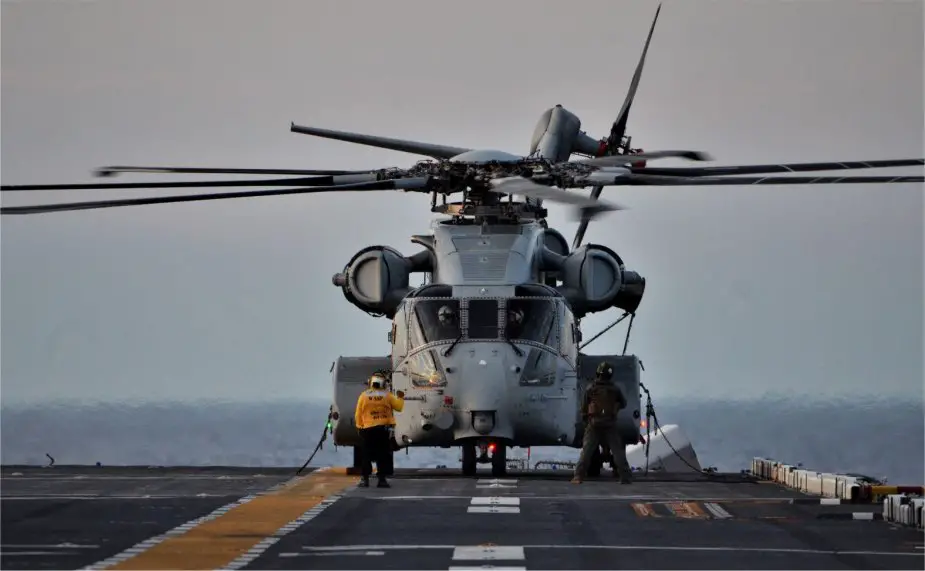Breaking news
US Navy completes 2nd sea trials of CH-53 King Stallion helicopter.
According to information published by the US Navy on April 5, 2023, the CH-53K King Stallion completed five full days and nights of envelope expansion testing at sea in the Atlantic. The aircraft continued testing in a modern naval environment following initial successful sea trials in June 2020.
Follow Navy Recognition on Google News at this link
 CH-53K King Stallion helicopter. (Picture source: Dvids)
CH-53K King Stallion helicopter. (Picture source: Dvids)
A diverse team of 105 personnel from Air Test and Evaluation Squadron Two One (HX-21), H-53 Heavy Lift Helicopters Program Office (PMA-261), Marine Heavy Helicopter Squadron 461 (HMH-461), Marine Operational Test and Evaluation Squadron One (VMX-1), and Sikorsky pilots, engineers, technicians, and maintainers successfully accomplished this second set of sea trials for the CH-53K. Sea trial testing took place aboard the USS Arlington, a San Antonio-class amphibious transport dock (LPD24), operated by the U.S. Navy.
Sea trials are a series of tests to evaluate the performance of the aircraft at sea. Tests performed during the event included: launch and recovery; rotor start and shutdown; blade fold; and shipboard compatibility testing – all in increasing wind speed and varying wind directions relative to the aircraft.
According to Sarah Naiva, Assistant Program Manager for Test and Evaluation for the CH-53K, there are many variables potentially impacting a high-profile, high-risk event such as sea trials.
Ship compatibility testing includes towing the aircraft around the deck and in the hangar, performing maintenance while aboard the ship, ensuring the aircraft fits in all the locations it needs to around the ship deck and hangar, and evaluating chain/tie-down procedures.
About the CH-53K
The CH-53K is a heavy-lift cargo helicopter developed by Sikorsky for the United States Marine Corps. It has a crew of 4 and can carry up to 30 passengers or troops, or 24 casualty litters with a payload of 35,000 lb (15,876 kg).
The helicopter has a centre external load hook rating of 36,000 lb (16,329 kg) and fore and aft external load hooks rating of 25,200 lb (11,431 kg). Its internal cargo system includes floor loading of 300 lb/sq ft (1,464.73 kg/m2), standard 6x 2,500 lb (1,134 kg) USMC 40 in × 48 in (1,016 mm × 1,219 mm) wooden pallets, full 463L pallets of 2x 10,000 lb (4,536 kg), and half 463L pallets of 5x 5,000 lb (2,268 kg). The helicopter can also carry a Tactical Bulk Fuel Delivery System with 3 × 800 US gal (666 imp gal; 3,028 l) tanks.
The CH-53K has a length of 99 ft (30 m) rotor and tail un-folded, 73 ft 1.5 in (22.29 m) fuselage, and a width of 17 ft 6 in (5.33 m) fuselage. Its height is 28 ft 4.9 in (8.659 m) rotor and tail un-folded, and its cabin length is 30 ft (9.1 m), width is 8 ft 7.2 in (2.6 m), and height is 6 ft 6 in (2.0 m).
The helicopter has a maximum takeoff weight of 88,000 lb (39,916 kg) with external load and 74,000 lb (33,566 kg) with maximum internal load. Its fuel capacity includes 2,286 US gal (1,903 imp gal; 8,650 l) internal in two cells per sponson (15,545 lb (7,051 kg)) and 2,400 US gal (2,000 imp gal; 9,100 l) auxiliary internal in three cabin tanks (16,320 lb (7,403 kg)).
The CH-53K is powered by three General Electric T408 (GE38-1B) turboshaft engines, each generating 7,500 shp (5,600 kW). It has a cruise speed of 170 kn (200 mph, 310 km/h) and a range of 460 nmi (530 mi, 850 km). Its combat range is 110 nmi (130 mi, 200 km) and it has a service ceiling of 16,000 ft (4,900 m) ISA or 13,200 ft (4,023 m) ISA +24 °C (75 °F).




























